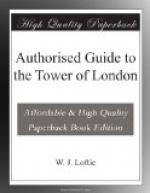Lord Hastings was also beheaded on Tower Green by order of the Duke of Gloucester in 1483.
The Beauchamp Tower
is on the west side of Tower Green, facing the White Tower, and is on the inner wall between the Bell Tower on the south and the Devereux Tower on the north, being connected with both by a walk along the parapet. Its present name probably refers to the residence in it as a prisoner of Thomas, third Earl of Warwick, of the Beauchamp family, who was attainted under Richard II in 1397, but restored to his honours and liberty two years later under Henry IV. It is curious that the most interesting associations of the place should be connected with his successors in the earldom. Although built entirely for defensive purposes, we find it thus early used as a prison, and during the two following centuries it seems to have been regarded as one of the most convenient places in which to lodge prisoners of rank, and in consequence many of the most interesting mural inscriptions are to be found in its chambers.
In plan the Beauchamp Tower is semicircular, and it projects eighteen feet beyond the face of the wall. It consists of three storeys, of which the middle one is on a level with the rampart, on which it formerly opened. The whole building dates from the reign of Edward III. We enter at the south-east corner and ascend by a circular staircase to the middle chamber, which is spacious and has a large window, with a fire-place. Here are to be found most of the inscriptions, some having been brought from other chambers. A few are in the entrance passage and on the stair. All are numbered and catalogued. The following—to which the numbers are appended—will be found the most interesting:—
2. On the ground-floor, near the entrance, ROBART DVDLEY. This was the fifth son of John, Duke of Northumberland, and next brother to Guildford Dudley, the husband of Lady Jane Grey. When his father was brought to the block in 1553 he and his brothers remained in prison here, Robert being condemned to death in 1554. In the following year he was liberated with his elder brother Ambrose, afterwards created Earl of Warwick, and his younger brother Henry. In the first year of Queen Elizabeth he was made Master of the House and elected a Knight of the Garter. In 1563 he was created Earl of Leicester. He died at Cornbury, in Oxfordshire, in 1588.
8. On the left, at the entrance of the great chamber, is a carved cross, with other religious emblems, with the name and arms of PEVEREL, and the date 1570. It is supposed to have been cut by a Roman Catholic prisoner confined during the reign of Queen Elizabeth.




